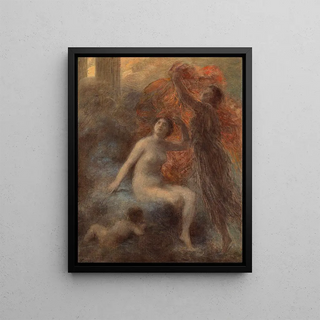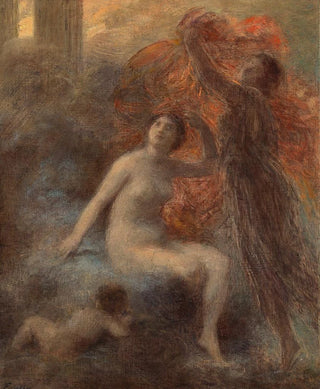Art print | The Palace of Dawn - Henri Fantin-Latour


View from behind

Frame (optional)
Reproduction Le Palais d'Aurore - Henri Fantin-Latour – Captivating Introduction
In the enchanting universe of art, certain works manage to capture the collective imagination, transcending eras and styles. "Le Palais d'Aurore" by Henri Fantin-Latour is a striking example. This canvas, imbued with poetry and delicacy, evokes a world where light plays a fundamental role, illuminating shapes and colors in a way that seems almost supernatural. By contemplating this work, the viewer is transported into a waking dream, where nature and imagination converge to give life to a vision that is both idyllic and ephemeral.
Style and uniqueness of the work
The uniqueness of "Le Palais d'Aurore" lies in how Fantin-Latour merges reality and dream. The painting, with its pastel shades and delicate nuances, creates an atmosphere of serenity and contemplation. The blurred forms and softened contours testify to a mastered technique, where each brushstroke seems to dance on the canvas, inviting the eye to wander through an dreamlike landscape. The artist uses light as a character in its own right, playing with reflections and shadows to bring this fantastic scene to life. This innovative approach, blending Impressionism and symbolism, makes this work a true masterpiece of the late 19th century, marking a crucial step in the evolution of modern art.
The artist and his influence
Henri Fantin-Latour, although often associated with his famous still lifes and portraits, established himself as a visionary within the artistic movement of his time. Born in 1836 in Paris, he was influenced by the great masters of art, while developing a style that is uniquely his own. His ability to capture emotions through delicate and poetic compositions made him an iconic figure of French art. Fantin-Latour surrounded himself with the greatest artists of his era, such as Claude Monet and Édouard Manet, but he also distinguished himself through his unique sensitivity. His work "Le Palais d'Aurore"

Matte finish

View from behind

Frame (optional)
Reproduction Le Palais d'Aurore - Henri Fantin-Latour – Captivating Introduction
In the enchanting universe of art, certain works manage to capture the collective imagination, transcending eras and styles. "Le Palais d'Aurore" by Henri Fantin-Latour is a striking example. This canvas, imbued with poetry and delicacy, evokes a world where light plays a fundamental role, illuminating shapes and colors in a way that seems almost supernatural. By contemplating this work, the viewer is transported into a waking dream, where nature and imagination converge to give life to a vision that is both idyllic and ephemeral.
Style and uniqueness of the work
The uniqueness of "Le Palais d'Aurore" lies in how Fantin-Latour merges reality and dream. The painting, with its pastel shades and delicate nuances, creates an atmosphere of serenity and contemplation. The blurred forms and softened contours testify to a mastered technique, where each brushstroke seems to dance on the canvas, inviting the eye to wander through an dreamlike landscape. The artist uses light as a character in its own right, playing with reflections and shadows to bring this fantastic scene to life. This innovative approach, blending Impressionism and symbolism, makes this work a true masterpiece of the late 19th century, marking a crucial step in the evolution of modern art.
The artist and his influence
Henri Fantin-Latour, although often associated with his famous still lifes and portraits, established himself as a visionary within the artistic movement of his time. Born in 1836 in Paris, he was influenced by the great masters of art, while developing a style that is uniquely his own. His ability to capture emotions through delicate and poetic compositions made him an iconic figure of French art. Fantin-Latour surrounded himself with the greatest artists of his era, such as Claude Monet and Édouard Manet, but he also distinguished himself through his unique sensitivity. His work "Le Palais d'Aurore"






